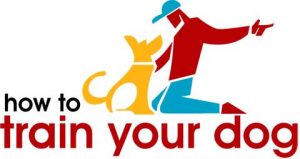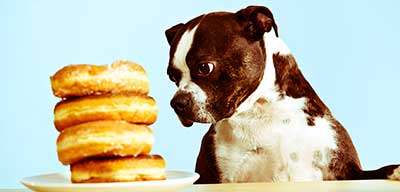There are plenty of human foods in the average household that our pets would love to get their paws on if they could, especially the less-fussy dogs of the home, but not all of them are healthy for them.
One of the most common food related questions from dog owners is can dogs eat bread?
It is too easy to feed dogs morsels of bread, a few scraps of toast at breakfast or the crusts that kids don’t want to eat, but is it a good idea? Is this simple food stuff safe for our pets to eat, or are there hidden dangers?
[thrive_text_block color=”blue” headline=””]
This guide on can dogs have bread will look at the issue from different sides to help you determine whether or not you want to continue to feed this food to your pet.
There are some that see no harm, others that see it as dangerous and many left in the middle struggling with portion sizes.
Here we will take a look at some of the different ingredients within bread that could prove to be harmful for dogs, important considerations to make when choosing or making bread and the best approaches to feeding bread to your pets.
[/thrive_text_block]
Table of Contents
Bread is viewed as both bad and safe, so which is true?
There are some different reports from pet owners online that paint different pictures on the risks of bread.
Some choose to not let their dogs go anywhere near it to avoid the potential dangers, while others are happy to let their dogs eat it because they have not personally seen any ill effects.
So which is the best approach? A great way of covering the issue is to replace the question of can they eat it with can dogs digest bread? This is where the problems can occur.
Why is bread bad for dogs?
There are major ingredients in bread that can be harmful, no matter what brand or type they eat.
[thrive_text_block color=”red” headline=””]This means that large quantities can have a negative effect on dogs. You may say my dog ate bread and he was fine, and assume that he can eat all he wants, but you may not see the full effects. [/thrive_text_block]
Sugar:
The first problem is sugar. We can often underestimate the amount of sugar that is put in our processed food and that means that there is more sugar in our diets then we expect.
We are starting to understand the danger to a bread heavy diet can have on human, so now consider the potential problems for dogs.
[thrive_text_block color=”red” headline=””]Dogs are far less tolerant of sugar and excessive bread consumption could have major consequences for ill health and weight gain. [/thrive_text_block]
It is possible to combat this to a degree with the type of bread you buy, but switching to brown and whole wheat won’t get rid of the issue.
Carbohydrates:
The additional problem here is that bread is full of carbohydrates, something that can also cause digestive problems and weight gain.
Human diets can be fixed considerably by switching to a low-carb diet and decreasing the amount of empty carbohydrates that can lead to weight gain.
[thrive_text_block color=”red” headline=””]
If your dog eats bread, that is a worthless source of carbohydrates that could eventually lead to obesity.
If you have ever wonder why your dog won’t lose weight after cutting back on certain “unhealthy treats,” but you still give them some simple toast in the morning, you may have your answer.
[/thrive_text_block]
These are some of the standard components of bread that can be harmful to dogs, but it is important to remember that there are many additional ingredients in bread that can also be a problem.
[thrive_text_block color=”red” headline=””]There are many specialist breads out there and different bread-based treats that make the question of is bread good for dogs even more difficult to answer. [/thrive_text_block]
Look out for the following:
Raisins:
A raisin bagel can be a great lunchtime treat for us, as we see the fruit as a healthy alternative to some of the other bread products we could be eating, but they can be dangerous for our dogs.
[thrive_text_block color=”red” headline=””] Not only are raisins potentially toxic to dogs, causing kidney failure and death, bagels are so dense and full of calories that a small portion could make a big difference.[/thrive_text_block]
Nuts and seeds:
There are many specialist breads that try and appeal to healthier individuals by changing the flour that is used, cutting back on the sugar content and adding plenty of nut and seeds to the dough for more flavour and nutrients.
[thrive_text_block color=”red” headline=””] Nuts are definitely to be avoided and it is worth checking the safety ratings of different seeds to make sure you do not accidentally poison your pet.[/thrive_text_block]
Onion and garlic:
Onion is another common filler in bread to add some more flavor or texture when a basic white loaf won’t do.
[thrive_text_block color=”red” headline=””]Whether this is a caramelized red onion or some basic onion powder, you should avoid giving this to your dog. Onion and garlic has be dangerous to animals because they can damage blood cells, leading to all sorts of medical problems. [/thrive_text_block]
Chocolate:
The last ingredient should go without saying, but there are still dog owners that think that a tiny amount of chocolate won’t hurt.
[thrive_text_block color=”red” headline=””] Chocolate is toxic to dog and should be avoided at all costs. This means that you cannot feed your dog scraps of your morning brioche if it has chocolate chips in it.[/thrive_text_block]
Other important health issue to consider when deciding whether to give bread to dogs.
The issues above are great examples of some of the dangerous ingredients that can often be found in bread-based products, and the ones that are mostly commonly highlighted by cautious owner.
[thrive_text_block color=”red” headline=””] The best rule is to avoid feeding your dog a piece of bread if it has ingredients in it that you are unsure about.[/thrive_text_block]
This does not mean that the potential health risks stop there, however, as the range of flavors is endless and there are other aspects to consider. Gluten intolerance, raw dough and the issue of feeding bread to puppies are all crucial here too.
Gluten intolerance:
The obvious answer to can dogs eat wheat bread is yes, under certain circumstances, but what about those with a gluten intolerance.
This dietary need is not restricted to humans and if your dog shows discomfort when eating any wheat-based food, take them to a vet to get them checked out.
Dogs are very rarely intolerant enough to be consider to suffer from celiac disease, but they can still get gastro-intestinal complaints and skin complaints from eating too much wheat.
[thrive_text_block color=”note” headline=””]If your pet is diagnosed with an intolerance, eliminate grains from the diet and be sure to avoid bread at all costs. [/thrive_text_block]
Raw bread dough:
When dealing with the issue of can I feed my dog bread, it is widely assumed that all owners are talking about baked bread that it’s on the counter.
The issue of raw bread dough cannot be overlooked, however, because it can be easy for dogs to gobble up this great-smelling food source if unattended.
[thrive_text_block color=”red” headline=””]Keep dogs out of the kitchen when baking bread because dogs and raw bread do not go together.
Raw dough has active ingredients and yeasts that can be very harmful to a dog. In some cases they can cause Ethanol Toxicosis. [/thrive_text_block]
What is Ethanol Toxicosis?
Ethanol Toxicosis occurs when the yeast in bread dough starts to ferment in the dog’s stomach.
This can cause excess gas and vomiting within as little as 30 minutes and, at its worse can cause comas, cardiac arrest and death.
Other symptoms to watch out for are light-headedness, bladder problems and lethargy.
This form of poisoning does not occur when the bread is cooked because the yeast is no longer active.
Any dog owner that suspects that their pet has eaten raw dough should contact a vet a watch out for these signs.
Puppies:
Can puppies eat bread is another important question that is asked by dog owners.
They may be happy to give their adult dog a few bits as a treat, but the idea of giving bread to a puppy has them concerned.
[thrive_text_block color=”blue” headline=””]At that early stage of their life, it is important to provide as healthy and balanced a diet as possible to ensure their growth and development and you don’t want to run the risk of giving them too much sugar and empty carbs with bread. [/thrive_text_block]
Some accidental scraps won’t do them much harm, but it is best to play it safe and avoid the risks of digestive discomfort at that young age.
Now you know what not to feed them, the important question is how much bread can dogs eat?
[thrive_text_block color=”red” headline=””]The initial idea here seems to be that standard bread is not too dangerous to dogs in small amounts, but specialist breads with odd ingredients and raw dough are to be avoided at all costs. [/thrive_text_block]
The problem is that there are clearly two different camps with their own ideas on the use of bread in a dog’s diet. On the one hand you have those that see no problem at all, and on the other you have those that would eliminate it completely.
Bread and dogs: to feed or not to feed.
Some dog owners may shrug the warning off, and there are definitely plenty of “my dog ate a loaf of bread and was fine” stories out there.
Dog owners have often found their pets tucking into a loaf that has been left unattended and laughed off the mischievous behavior because they have seen no immediate ill effect.
The additional issue here is the fact that bread is pretty habit-forming. Dogs have a desire for bread that is similar to our own, only we see it as a staple part of a diet while they see it as a treat.
Many owners see no need to take this basic, affordable treat away if it not making them ill.
[thrive_text_block color=”note” headline=””] By sticking with normal loaves and avoiding the dangerous specialty breads, it can be easy to feel as though you are doing the right thing.[/thrive_text_block]
The problem here is that it is important to look at the long-term effects of bread consumption rather than just immediate toxicity.
[thrive_text_block color=”red” headline=””]A slice of bread a day may not look like “too much”, but over time it could prove to be a problem, especially when dogs develop a dependency on it. This is why some dog owners prefer to eliminate bread from their dog’s diet all-together. [/thrive_text_block]
They question why should dogs eat bread at all if there is no need for it in their diet and it poses these risks.
The root of this argument is the fact that dogs get no nutritional value from bread that they can’t get from a better source.
With the right diet and a balanced formula in their dog food, they should get all of the nutrients they need and a healthy amount of beneficial carbohydrates without having to eat bread.
[thrive_text_block color=”note” headline=””] Bread is a tasty treat, but there could be better options out there that don’t pose the risk of digestive issues and weight gain.[/thrive_text_block]
Some owners would counter this by highlighting the fibre count in bread, asking “why can’t my dog eat bread for the fibre when they have digestive problems.”
[thrive_text_block color=”blue” headline=””]There are some owners that use bread as a quick source of fibre to solve constipation problems, but this still needs to be done in small, considerate amounts. [/thrive_text_block]
Again, with the right diet, you should be able to provide enough fibre for your dog without having to throw them bread crusts every day. Chickpeas and oatmeal are much better for them.
So what is the solution here, and is there a middle ground where you can still feed your dog bread?
If you don’t want to deprive your dogs of a treat they have grown to love, but don’t want to risk overfeeding them and causing health problems either, it is all about providing small treat-sized morsels of the right type of bread.
If you can stick to the safer forms and restrict access you should be able to safely feed bread to your pet.
Finding bread for dogs that is safe to eat
So what bread should you feed them if you want to treat them but not harm them?
The first step is to avoid all of the options listed above and to stick with simple flavors with a low sugar content.
This leads to the great debate on shop bought vs homemade.
[thrive_text_block color=”note” headline=””]One potential compromise here is to make sure that you only feed your dogs homemade bread where you are 100% certain of the ingredients that have gone into it. [/thrive_text_block]
Not only does this mean that any scraps that are eaten are less likely to cause health problems, you can experiment with recipes and flavors that the whole family can enjoy.
Homemade options can be a lot healthier if they use different types of flour, less sugar, less salt or other interesting extras like pumpkin.
The only downside here is that this can be time consuming in a busy family home and it is always handy to have a shop bought loaf in the house for sandwich making.
Just be sure to keep this loaf out of sight of dogs so they stick to the good stuff.
Can dogs eat banana bread?
This is another question that comes up a lot when dog owners question the types of bread that their pets can eat – probably because dogs seem to be so fond of it.
[thrive_text_block color=”blue” headline=””]Banana bread should be treated like most other breads that have been mentioned so far. When it is basic, with good ingredients, it can be used as a treat without running too much risk of causing any health problems. [/thrive_text_block]
You must make sure to check the ingredients, however, as many shop bought versions have additional components such as chocolate chips.
This is again where baking homemade bread is such a great idea. You can be sure of a homemade treat for the family that suits everyone’s tastes.
Can dogs eat bread? (conclusion)
In the end, the issue of feeding bread to dogs comes down to three simple issues: underlying health conditions, ingredients and portion size.
There are many human foods that are recommended in moderation only, and bread is a great example of that.
It may be too much to advise all dog owners to give up feeding their pets bread entirely if they have become so depend it on, and it is too readily available in the house, but it is crucial that you manage the amount that they eat to avoid long-term health risks and obesity.
A normal loaf of white bread will not be toxic to dogs, but it is not healthy either.
If you are feeding bits of toast and nothing more, there is little you need to change. Any more and you may need to think about cutting back.
As long as you check for gluten intolerance, check all the ingredients and control the portion sizes, you should be fine.





